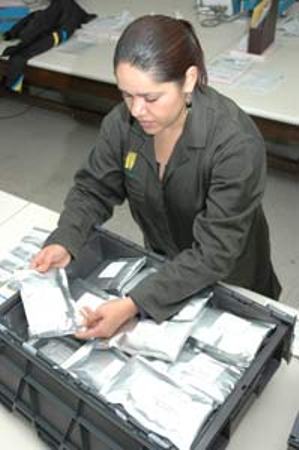Safety duplication of maize genetic resources
Contributors to this page: CIMMYT, Mexico (Suketoshi Taba, Bonnie J. Furman), with inputs also received from IITA, Nigeria (Dominique Dumet), EMBRAPA (maize and sorghum genebank), Brazil (Flavia Teixeira), USDA (ARS/NC7, ISU), USA (Mark Millard).
When should it be used
- Always. A safety backup should be kept of all unique accessions under ideal conditions. See also the general page on safety duplication procedures.
- If possible, every genebank should have a base collection for long-term backup on site.
- Black-box safety duplication should be used by crop genetic resource conservation networks, in a genebank of choice.
- A secondary “ultimate” backup at the Svalbard Global Seed Bank is ideal.
- In some cases, it is beneficial to have germplasm incorporated into the active collection of a sister genebank. In the case of integration of the safety duplicates, the recipient genebank will need to register the accessions.
 A research assistant for CIMMYT’s wheat germplasm |
Minimum sample size
- A regeneration set of at least 512 seeds of each accession should be sent to the designated or collaborating genebank as black-box safety duplicates.
- See also recommendations from the general page on safety duplication procedures of this site.
Viability for storage
- Seed viability above 85% is preferred.
- See also recommendations from the general page on safety duplication procedures of this site.
Moisture content
- Seed moisture content should be 6-8%.
- See also recommendations from the general page on safety duplication procedures of this site.
Container specifications
To ensure both seed viability in the genebank and accession safety en route to the users.
Seed packaging method
- One or two aluminum foil pouches should be packaged with the dried seeds as mentioned above for the base collection.
- For the black-box, several pouches of the seed samples should be included in a cardboard or plastic box that can be placed in the racks of the designated or collaborating genebank.
Specifications of packaging material
- Side-gusseted stand-up pouches of aluminum foil (custom-made) for about 1 kg maize seeds [size 3.5”x 10.5” x 1.25” (expands to 2.5”)].
- An example of the aluminum foil pouches is supplied by KAPAK Corporation, 5303 Parkdale Drive, Minneapolis, MN 55416-1681, USA.
Storage specifications
Assigning location codes
To facilitate the access to the seed accessions stored in the genebank.
- The seed accessions should be stored in an orderly way.
- The row, column, level, and box (sample within box) in the storage racks should be identified by two digit numbers.
- A prefix can be assigned to denote row, column, level, box and sample numbers.

Each bag has a label containing all the necessary information about its contents (photo: CIMMYT) |
Storage conditions
To ensure longevity of the seed viability.
- As stated in the genebank standards (FAO/IPGRI 1994), storage at less than -18oC is preferred.
Shipping method
- Prepare the documentation of outgoing seed shipments with phytosanitary certificate, an import permit and others, as needed.
- Follow the same procedures for the seed shipments from the genebank.
- Boxes should be shipped using the most reliable, quickest and most cost effective route and carrier possible.
- Avoid shipments during hot times of the year.
Legal arrangements
- A Memorandum of Understanding (MOU) or the Germplasm Acquisition Agreement (GAA) with the collaborating genebanks and institutions will be needed.
- See also recommendations from the general page on safety duplication procedures of this site.
Recording information during safety duplication
The following information must be recorded for each consignment:
- Accession number (number).
- Collection name, pedigree (name and number).
- Associate number (if germplasm is held in another genebank, include that genebank’s accession numbers).
- Collection site (country of origin, state name, longitude, latitude, altitude).
- Donor (donor institution).
- Race class (maize race, race purity, common name).
- Grain type (texture, colour).
- Origin of the stored seeds (location, year, field plot, sample).
- Photo [sample photo of ear and/or kernels (grain type: colours and textures)].
- Reference sample (location in the bank, seed origin).
- Seed exchange policy (MLS, specific).
- Seed health (specify if cleared for outgoing, or if not cleared).
- Seed shipment (collaborator, institution, country).
- Safety duplicate storage (collaborating genebanks).
- Seed monitoring (seed amounts and seed viability).
- Accession availability status (available, not available).
- Storage address (row-column-level-sample).
- Amount of seed stored (seed number or seed weight).
References and further reading
FAO/IPGRI. 1994. Genebank standards. Food and Agriculture Organization of the United Nations, Rome and International Plant Genetic Resources Institute, Rome. Available in English, Spanish, French and Arabic .
Pardey PG, Koo B, Wright BD, Van Dusen ME, Skovmand B, Taba S. 2001. Costing the conservation of genetic resources: CIMMYT’s ex situ maize and wheat collection. Crop Science 41(4):1286-1299. Available from : http://sgrp.cgiar.org/sites/default/files/Pardey-2001.pdf. Accessed: 15 September 2010.
Comments
- No comments found





Leave your comments
Post comment as a guest